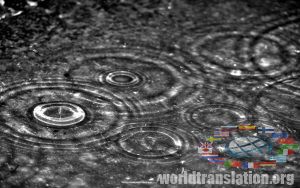Rain

Rain - is atmospheric precipitations which falls in the form of droplets from clouds (0.5 - 7 mm). Precipitations with droplets of a smaller diameter - is drizzle. Droplets with a diameter of more than 7 mm during the fall break into smaller droplets, that is why, even during the strongest rainfall droplet diameter does not exceed 7 mm. The intensity of rain varies between 0.25 - 100 mm/h.
Precipitations with droplets of a smaller diameter - is drizzle. Droplets with a diameter of more than 7 mm during the fall break into smaller droplets, that is why, even during the strongest rainfall droplet diameter does not exceed 7 mm. The intensity of rain varies between 0.25 - 100 mm/h.
The mechanism of formation
 Frequently rain falls from altostratus and nimbostratus clouds, which at temperatures less than 0 ° C, contain ice crystals and supercooled droplets. At the same temperature, saturation pressure of water vapor over the ice crystals is smaller than over the drops, that is why cloud which is oversaturated with water vapor to the crystal, is not saturated in relation to water droplets.
Frequently rain falls from altostratus and nimbostratus clouds, which at temperatures less than 0 ° C, contain ice crystals and supercooled droplets. At the same temperature, saturation pressure of water vapor over the ice crystals is smaller than over the drops, that is why cloud which is oversaturated with water vapor to the crystal, is not saturated in relation to water droplets.  Thus, while simultaneously evaporation of droplets, this leads to the growth of crystals. Crystals enlarging and becoming heavier, drop out of the cloud, and at the same freezes supercooled droplets to itself. After coming under a cloud, or its bottom part, in its layers with a temperature of 0 ° C, crystals melt - turning into rain drops.
Thus, while simultaneously evaporation of droplets, this leads to the growth of crystals. Crystals enlarging and becoming heavier, drop out of the cloud, and at the same freezes supercooled droplets to itself. After coming under a cloud, or its bottom part, in its layers with a temperature of 0 ° C, crystals melt - turning into rain drops.  Lesser role in the formation of rain plays merging of cloud droplets.
Lesser role in the formation of rain plays merging of cloud droplets.
If sun shines flying rain drops, sometimes we can see a rainbow.
Prolonged lack of rain leads to drought.
Conditions of formation
 On different planets, as a phenomenon of nature - the rain can be present in their atmospheres only at certain temperatures. Thus our planet Earth and Titan - a satellite of Saturn planet, have a necessary conditions. Essence of these events is as follows: the
On different planets, as a phenomenon of nature - the rain can be present in their atmospheres only at certain temperatures. Thus our planet Earth and Titan - a satellite of Saturn planet, have a necessary conditions. Essence of these events is as follows: the  temperature in lower atmospheric layers can support some substance in 2 or 3 aggregate states. On planet Earth - its water, so lower atmospheric levels of the Earth allow water to stay in all 3 aggregate states. On the
temperature in lower atmospheric layers can support some substance in 2 or 3 aggregate states. On planet Earth - its water, so lower atmospheric levels of the Earth allow water to stay in all 3 aggregate states. On the  planet Titan temperature promotes precipitation of methane rain (in such circumstances, methane can be a liquid or gas).
planet Titan temperature promotes precipitation of methane rain (in such circumstances, methane can be a liquid or gas).
The formation of rain clouds occurs:
- upon contact of humid air with more cold ground surface;
- from the mixing of 2 air masses which have different temperatures but which are close to saturation;
- in the rising air currents.
The distribution of precipitation and rains by seasons and whole earth's surface has a very important climatic value.
Acid rain
 Normal rain has a acidity pH=5,6. Acid rain has a lower pH. So when the acidity of the water pH=5.5 - die all the beneficial bacteria of the pond, at pH=4.5 die most amphibians, insects, and all the fish. Acid rains are the big problem for many regions, with developed industrial infrastructure, as large enterprises emit oxides of nitrogen and sulfur, which give different acids.
Normal rain has a acidity pH=5,6. Acid rain has a lower pH. So when the acidity of the water pH=5.5 - die all the beneficial bacteria of the pond, at pH=4.5 die most amphibians, insects, and all the fish. Acid rains are the big problem for many regions, with developed industrial infrastructure, as large enterprises emit oxides of nitrogen and sulfur, which give different acids.
Types of rainfalls:
- Light;
- Moderate;
- Heavy;
- Violent.